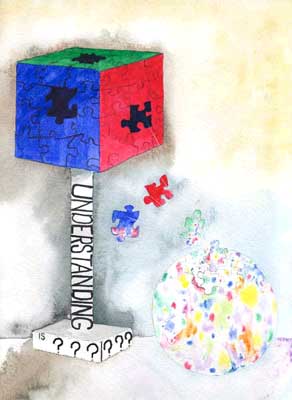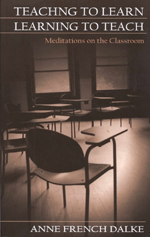
Bridging Cultures Institute 2002


| Bridging Cultures Institute 2002 |
It is the logo for today's discussion, and here's what it looks like...

We'll get back to it in a bit, after we've recalled...
I want to turn especially to the work of
Anne
Fausto-Sterling ,
Professor of Biology and Women's Studies @ Brown University
esp. her article "Science Matters, Culture Matters."
Circulating Draft. January 2002,
which offers a new model for teaching "science in a social context" and emphasizes the embedded nature of every topic in her course. She begins each topic by having students construct a "knowledge web" (for ex, neural tubes are embedded in matrix of medical/social questions), and ends each one w/ a "web expansion unit," in which the students design collaborative projects: they expand on topics that intersect w/ the main subject matter, starting w/ a place familiar to them, but moving beyond the personal to large cultural issues.....
Fausto-Sterling draws on Bruno Latour's observations about complex stories ("hybrids") in daily papers:, and argues that trad'l science made hybrids disappear ("for a scientist work must be an out of body experience"); she also draws on Emily Martin's two metaphors: the "citadel" vs. a "rhizome" (an underground root), suggesting tht we "have to fence in subject matter to make it manageable, but the fences should be picket or lattice--something the students can see through to the landscape beyond."
big take home lesson: imperfection of science/uncertain nature of knowledge (see also Forms of science)
second take home lesson: the generative power of metaphor, as a way of organizing information
(see George Lakoff, Philosophy in the Flesh
(see also Teaching to Learn, Learning to Teach

Let's pause and generate a list of metaphors for our own classroom experiences, (see responses as blackboard photo or as table)
Going a step further now....
to talk not just about encouraging more students to do science,
but about changing the nature of science itself, by involving
different types of students in it....
Ray McDermott and Herve Vareene, "Culture As Disability." Anthropology and Education Quarterly 26, 3 (1995): 324-348.
H.G. Wells, The
Country of the Blind (1913)
Herman Melville, Moby-Dick: or, The Whale (1851)
Now marvelously re-written, filling in aspects missing from the old ...
Sena Jeter Naslund, Ahab's Wife, or, The Star-Gazer (1999)
Let's try this re-writing of stories, drawing on our own diversity, celebrating the diversity of the natural world, in science (cf. Paul Grobstein, Diversity and Deviance (1989)):
Read a couple of articles about our "favorite" science-in-the-news event: the arrival of the snakehead.
ALTERNATIVE:
Recall your metaphors for your self as teacher, for students and classrooms, and look over those described by others. What new metaphors might you create which might reduce the "disabilities" inherent in your own earlier metaphors? Write about your new metaphors in the institute forum area. (see responses).
To conclude: Fausto-Sterling writes of "our anachronism":